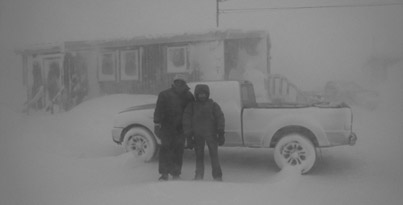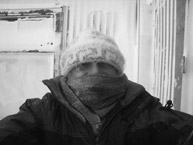Notes from the Field: A blizzard of opportunity
Notes from the Field: A blizzard of opportunity McGill University
User Tools (skip):
NOTES FROM THE FIELD
A blizzard of opportunity

McGill prof David Brown (above left and below) and Memorial University grad student Melanie Irvine pose during the white-out in Clyde River.
Mark Ednie
Snowed-in climate change researchers band together
Sometimes the weather conspires to make an outstanding trip truly extraordinary. This was the case when I traveled to Clyde River, Nunavut, with a group of Natural Resources Canada (NRCan) scientists and government officials on a mission with the lofty goal of enhancing the resilience of Inuit communities to climate change. The team included experts in remote sensing, sea level rise, coastal geosciences, geology, landscape hazards, permafrost monitoring, engineering, and community planning, as well as government officials affiliated with Indian and Northern Affairs and the government of Nunavut. My own role was to represent the Canadian Institute of Planners which, with funding from NRCan, has a project to promote climate change adaptation in planning practice throughout the country and I was in the process of completing a case study in Clyde River.
We arrived in Clyde River March 3, intending to present the results of climate change research work to the community and meet the team's local partners to discuss next steps before flying back to Iqaluit the next day. As luck would have it, we were not able to return to Iqaluit until March 6.
The presentations went very well. Of the 800 Inuit residents in the hamlet, 40 attended the meeting. The audience listened attentively and a number of people, mostly elders and hunters, posed insightful questions or made comments on the research. Following the presentations many stayed to talk with the researchers and look at the posters on display. It was particularly impressive to see elderly Inuit women carefully examining air photos dating from the 1950s and using magnifying glasses to locate structures they had lived in years before. Clearly the results of the scientific work were being effectively communicated to the residents and, equally important, the residents were effectively conveying useful information to the research team.
Pleased with the meeting, we returned to the small house where we were staying, told tales of other Arctic trips, laid out our sleeping bags on the floor and slept soundly. By morning, however, there had been a dramatic shift in the weather. Blizzard warnings were in effect and it appeared unlikely we would be able to fly out that evening as planned.

The blizzard gained force during the day and we resigned ourselves to staying over several days. Menus were quickly planned, volunteers offered to do the cooking and washing up, and a team went out on foot into the cold to secure provisions from the general store. Fortunately, the worsening weather was accompanied by an increase in the level of interaction. And, in addition to embellishments on the old war stories from the night before, we began to exchange ideas that bridged the many disciplines that were represented by the group.
When we awoke the following morning, the blizzard was at full force. Visibility was near zero and the snow, driven hard by the wind, was compacting and interlocking crystals to form a mass with sufficient structural strength to cut and stack. In short, perfect building blocks for an igloo.
As this was my first visit to the Arctic, I was eager to experience the blizzard first hand. So with the excuse that I was conducting a land-use survey I ventured out with two of the scientists to explore the hamlet. The snow swirled in gusts about us as we walked leaning at sharp angles into the wind, finding our way along the tracks by following lines of telephone poles. It was another world, at once brutal and magnificent.
Returning to the warmth of our house, we found everyone connected to the high-speed wireless network of the non-governmental organization next door and hard at work. And so we joined in, downloading documents, data, maps and air photos, sharing favorite websites, preparing reports and presentations and engaging in conversations that spanned our disciplines. It was a rich experience as we collectively had the skills to move from knowledge to action, from basic science discoveries, through policies and plans, to community involvement, and ultimately to issues relating to project implementation.
Along the way it became clear that while climate change is a very serious issue with major consequences especially for northern regions, it also provides opportunities for new research and a strengthening of the sense of community in many localities. Keen to make a real difference, the scientists adopted a multifaceted approach that included training local Inuit to make scientific observations, fostering community monitoring programs, offering course modules in schools, and working with other professionals to engage the community with the goal of preparing and implementing measures that would enhance the resilience of the community to climate change. I returned to Montreal March 7, with a renewed appreciation for interdisciplinary projects, respect for northern storms – and bragging rights when a major winter storm hit the city the following day.
David Brown is the Director of the School of Urban Planning at McGill. Educated at Bishop's University (BA Geography), McGill (MUP) and Sheffield University where he completed his doctorate in planning, he teaches graduate level planning studios, urban environmental planning, geographic information system applications and planning methods. He is a member of the Ordre des urbanistes du Québec and the Canadian Institute of Planners. His research interests focus on environmental governance, environmental planning and management, geographic information systems, planning in developing countries and the role of public institutions, community groups and citizens in the planning and development process.

